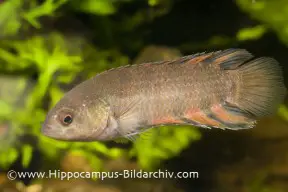Microctenopoma ansorgii
Ornate ctenopoma
Classification
Anabantidae
Distribution
Native to the River Congo basin in parts of both the Republic of Congo and Democratic Republic of Congo. Apparently a feral population exists on the island of Madagascar.
Habitat
Native to the River Congo basin in parts of both the Republic of Congo and Democratic Republic of Congo. Apparently a feral population exists on the island of Madagascar.
Maximum Standard Length
2.4″ (7cm)
Aquarium SizeTop ↑
30″ x 12″ x 12″ (975x30x30cm)
Maintenance
Prefers a densely planted tank with lots of floating cover and stained water. Peat filtration is beneficial. The tank should be well-covered as these fish are great escape artists.
Water Conditions
Temperature: 68-80°F (20-27°C), but aim for the upper end of this range.
pH: 5.5-7.5
Hardness: 5-20 dH
Diet
Provide a diet consisting mainly of small frozen or live food. Rarely accepts dried foods.
Behaviour and CompatibilityTop ↑
This is quite a slow-moving fish and will easily be out-competed by more boisterous species at feeding time, so is best kept with small, peaceful species that inhabit the upper and lower parts of the tank such as hatchetfish, lampeyes, corydoras and small loricariids. We believe it is stunning enough to deserve a species tank, in which it will do best. Males may be aggressive to one another, particularly if spawning.
Sexual Dimorphism
Males are the larger sex and are much more colourful. They also have white edges to the anal and dorsal fins.
Reproduction
Possible but tricky. Bubblenester. A dimly-lit, well-planted aquarium with lots of floating plants and soft, acidic water is required to spawn these fish. Condition them with live food. The male will build a very small, loose bubblenest of large bubbles amongst floating vegetation or under a broad leaf. Spawning occurs under the nest in a typical anabantoid embrace. Up to 600 eggs may be laid, which hatch in around 24 hours and become free-swimming in 2-3 days. It is best to remove the parents after hatching. The fry are tiny and should be fed infusoria for the first week, after which they will accept brine shrimp nauplii.
NotesTop ↑
This is the most colourful of the African anabantoids and is much sought after by hobbyists. A male in full breeding dress is truly a sight to behold. In nature it can be found in small streams, inhabiting areas of dense vegetation close to the riverbanks. It is difficult to collect a lot of fish from these habitats and so M. ansorgei is relatively rare in the hobby. These fish can be difficult to acclimatise but once settled are very hardy and can live up to 5 years in the aquarium.


May 29th, 2016 at 12:29 pm
From their behavior, I think providing shelters may be most important. I’ve seen specimens in LFS huddle against/under any available object. My male has lived comfortably for several years in a ceramic log in a planted community tank. Comes out to eat or swim between caves patrolling territory, shows no stress from other species of fish. Sits at entrance with head out of cave and watches. “Sneaks up” from shelter and “pounces” on sinking carnivore pellets. Clearly a territorial ambush hunter. Isn’t timid about jumping in for food, just wants to grab larger items at the bottom, not feed on small items from the surface.